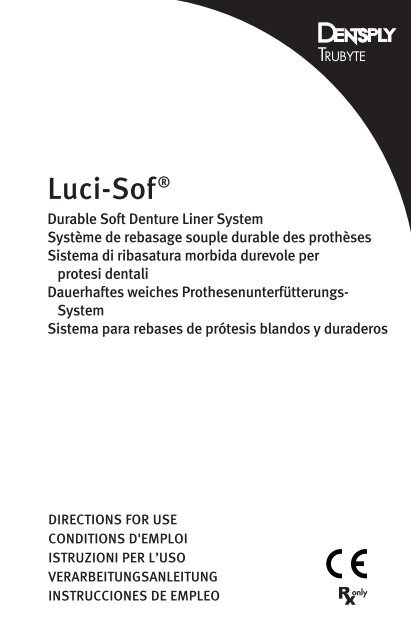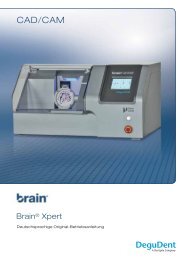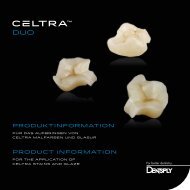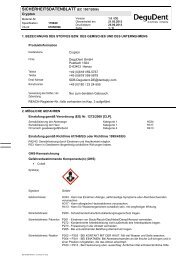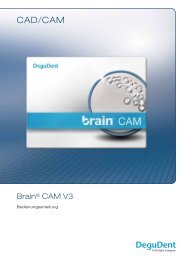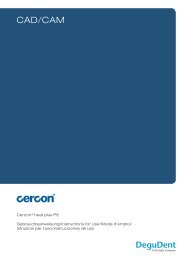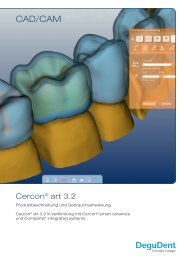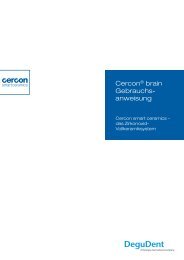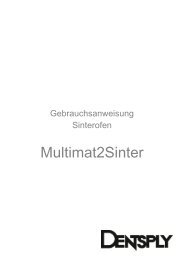You also want an ePaper? Increase the reach of your titles
YUMPU automatically turns print PDFs into web optimized ePapers that Google loves.
<strong>Luci</strong>-Sof ®<br />
Durable Soft Denture Liner System<br />
Système de rebasage souple durable des prothèses<br />
Sistema di ribasatura morbida durevole per<br />
protesi dentali<br />
Dauerhaftes weiches Prothesenunterfütterungs-<br />
System<br />
Sistema para rebases de prótesis blandos y duraderos<br />
DIRECTIONS FOR USE<br />
CONDITIONS D'EMPLOI<br />
ISTRUZIONI PER L’USO<br />
VERARBEITUNGSANLEITUNG<br />
INSTRUCCIONES DE EMPLEO
Indications for use:<br />
The <strong>Luci</strong>-Sof Soft Denture Liner<br />
System is intended for use as a longterm<br />
resilient lining material for<br />
removable dentures.<br />
The <strong>Luci</strong>-Sof Denture Liner System<br />
consists of two components:<br />
1. <strong>Luci</strong>-Sof Soft Denture Liner: a<br />
heat polymerizable, one component<br />
silicone putty that is based<br />
on dimethylpolysiloxane,<br />
dimethyl, methyl hydrogen siloxane<br />
copolymer; reinforced with<br />
amorphous silica. Benzoyl peroxide<br />
is the initiator for polymerization.<br />
2. <strong>Luci</strong>-Sof Bonder: a heat polymerizable<br />
methacrylate monomer<br />
liquid and methacrylate polymer<br />
blend.<br />
Contraindications:<br />
1. <strong>Luci</strong>-Sof Bonder is contraindicated<br />
for patients and users with a<br />
history of allergic reactions to<br />
methyl methacrylate monomer.<br />
Warnings:<br />
1. <strong>Luci</strong>-Sof Bonder contains polymerizable<br />
monomers which may<br />
cause skin sensitization (allergic<br />
contact dermatitis) or other allergic<br />
reactions in susceptible individuals.<br />
Wash thoroughly with<br />
soap and water after contact. If<br />
skin sensitization or other allergic<br />
reactions occur, discontinue<br />
use. If dermatitis or other symptoms<br />
persist, seek medical<br />
advice.<br />
2. Avoid inhalation or ingestion of<br />
<strong>Luci</strong>-Sof Bonder. High vapor con-<br />
1<br />
centration can induce headache,<br />
nausea, and irritation of eyes<br />
and respiratory system. Liquid<br />
contact with eyes may cause possible<br />
corneal damage. Excessive<br />
long-term exposure may be associated<br />
with other more serious<br />
health effects. Monitor air quality<br />
per OSHA standards.<br />
Inhalation: Move subject to fresh<br />
air. Give oxygen or artificial respiration<br />
as required.<br />
Ingestion: Contact your regional<br />
Poison Control Center immediately.<br />
Eye Contact: Flush eyes promptly<br />
with copious amounts of water<br />
for 15 minutes, and consult a<br />
physician. Wash skin with soap<br />
and water.<br />
Precautions:<br />
l. Do not use <strong>Luci</strong>-Sof Soft Denture<br />
Liner on dentures that will result<br />
in denture base acrylic that is<br />
less than 2 mm in thickness.<br />
2. Do not use the alternative long<br />
cure cycle (9 hours at 163° F)<br />
when lining a new denture.<br />
3. Users with special skin problems,<br />
cuts or abrasions should<br />
wear protective gloves.<br />
4. When grinding prosthodontic<br />
resins, proper ventilation, masks<br />
and vacuum systems should be<br />
used.<br />
5. Refrigeration of <strong>Luci</strong>-Sof Soft<br />
Denture Liner is recommended.<br />
Always bring to room temperature<br />
before use. Do not store next<br />
to amine containing chemicals<br />
(ie. acrylic repair liquid, adhesive
accelerator, etc.) as this may<br />
cause discoloration of the <strong>Luci</strong>-<br />
Sof mate-rial.<br />
6. Store <strong>Luci</strong>-Sof Bonder below 80°<br />
F (27° C) and away from direct<br />
sunlight. May be refrigerated to<br />
extend shelf life.<br />
7. Eugenol containing dental materials<br />
should not be used in conjunction<br />
with this product since<br />
they may interfere with hardening<br />
and bonding.<br />
8. Unused <strong>Luci</strong>-Sof Soft Denture<br />
Liner should be polymerized<br />
prior to disposal.<br />
9. <strong>Luci</strong>-Sof Bonder is a hazardous<br />
material. Dispose of in accordance<br />
with Federal, State, and<br />
Local regulations.<br />
Adverse Reactions:<br />
1. Corneal damage, headache, nausea,<br />
and vomiting may occur with<br />
exposure to methyl methacrylate<br />
monomer. (See Warnings and<br />
Precautions statements.)<br />
2. Allergic contact dermatitis and<br />
other allergic reactions may<br />
occur in susceptible individuals.<br />
3. Particulates will be generated<br />
when grinding prosthodontic<br />
materials. Eye, skin and respiratory<br />
irritation may occur if appropriate<br />
engineering controls are<br />
not used.<br />
STEP-BY-STEP INSTRUCTIONS:<br />
Relining An Existing Denture<br />
<strong>Luci</strong>-Sof Soft Denture Liner System is<br />
a long-term silicone heat-cured soft<br />
denture liner material and bonder.<br />
2<br />
1. Pour a stone cast of the impression<br />
in the denture to achieve the<br />
desired contour.<br />
2. Trim excess impression material,<br />
smooth with wax and finish to<br />
final shape around the periphery.<br />
This preparation will help to<br />
minimize finishing later.<br />
3. Invest.<br />
4. Open flask and remove wax with<br />
boiling water.<br />
5. Remove impression material.<br />
6. Wash with detergent and water<br />
and rinse with clean boiling<br />
water.<br />
7. Grind the denture surface with a<br />
clean carbide cutter to remove<br />
tray adhesive and sufficient<br />
acrylic. A clean surface is necessary<br />
to achieve a superior bond<br />
to the denture base. Avoid knife<br />
edges. Grind flange border to a<br />
90° butt joint.<br />
8. Shake the <strong>Luci</strong>-Sof Reline Bonder<br />
well and generously coat the areas<br />
Denture<br />
Base<br />
<strong>Luci</strong>-Sof<br />
of the denture to be bonded.<br />
9. Wash brush and dampen brush<br />
with monomer and dry with a<br />
paper towel.<br />
10. Allow the Bonder to dry for 15<br />
minutes.<br />
11. Trial pack the <strong>Luci</strong>-Sof Soft<br />
Denture Liner. Add material to<br />
borders and heel areas to<br />
achieve uniform flash.
12. Immediately process in a compress<br />
for 2 1 ⁄2 hours in boiling<br />
water. (Alternative cure method:<br />
9 hours at 163° F followed by a 30<br />
minute boil.) Cool 15 minutes on<br />
the bench and then place in room<br />
temperature water for 15 minutes.<br />
13.Remove excess material with a<br />
scalpel and contour with a Faskut<br />
<strong>Luci</strong>-Sof Bur. (Large #904765,<br />
Medium #904764, Small<br />
#904763)<br />
14. Polish with Tripoli and felt wheel<br />
at high speed.<br />
Lining A New Denture<br />
1. Flask waxed-up denture using<br />
conventional methods.<br />
2. Boil out and wash with detergent<br />
and water, then rinse with clean<br />
boiling water.<br />
3. Prepare a 2-3 mm shim on the cast.<br />
4. Pack denture base material and<br />
close flask. Bench set denture<br />
base under pressure until a firm<br />
3<br />
consistency is achieved (60 min.<br />
for <strong>Luci</strong>tone 199 ® Denture Base).<br />
Bench set time may vary for other<br />
brands of denture base.<br />
5. Remove shim and trial pack the<br />
<strong>Luci</strong>-Sof Soft Denture Liner. Do<br />
not use <strong>Luci</strong>-Sof Bonder. Under -<br />
pack the first trial and then add<br />
material to heel areas and borders.<br />
6. Immediately process in a compress<br />
for 1 1⁄2 hours at 163° F, followed<br />
by 2 1⁄2 hours in boiling<br />
water. Cool 15 minutes on the<br />
bench and then place in room<br />
temperature water for 15 minutes.<br />
7. Remove excess material with a<br />
scalpel and contour with a Faskut<br />
<strong>Luci</strong>-Sof Bur. (Large #904765,<br />
Medium #904764, Small<br />
#904763)<br />
8. Polish with Tripoli and felt wheel<br />
at high speed.
AVERTISSEMENT: les lois fédérales<br />
américaines limitent l'usage de ce<br />
produit à l'art dentaire et à sa prescription<br />
par un chirurgien dentiste.<br />
Indications: Le <strong>Luci</strong>-Sof de rebasage<br />
souple des prothèses, est un matériau<br />
conçu pour le rebasage élastique<br />
permanent (long terme) des prothèses<br />
adjointes.<br />
Le <strong>Luci</strong>-Sof Soft Denture Liner System<br />
est composé de deux produits:<br />
1 Le <strong>Luci</strong>-Sof Soft Denture Liner: un<br />
silicone putty mono composant<br />
thermo polymérisable à base de<br />
copolymère de<br />
diméthylpolysiloxane, diméthyl,<br />
méthyle hydrogène siloxane, renforcé<br />
avec de la silice amorphe.<br />
Le péroxyde de benzoyl est l'initiateur<br />
de la polymérisation.<br />
2 Le <strong>Luci</strong>-Sof Bonder : une résine<br />
thermopolymérisable à base de<br />
monomère liquide de métacrylate<br />
et d'un mélange de polymère<br />
de métacrylate.<br />
Contre-indications:<br />
1. <strong>Luci</strong>-Sof Bonder est contre<br />
indiqué chez les patients et par<br />
les utilisateurs présentants ou<br />
ayant présenté des réactions<br />
allergiques au monomère de<br />
métacrylate de méthyl.<br />
Avertissement:<br />
1. <strong>Luci</strong>-Sof Bonder contient des<br />
monomères polymérisables susceptibles<br />
de provoquer des sensibilisations<br />
cutanées (dermites<br />
de contact allergique) ou<br />
d'autres réactions allergiques<br />
chez des personnes prédisposées.<br />
Laver abondamment à<br />
l'eau et au savon après contact.<br />
En cas de manifestation cutanée<br />
4<br />
ou allergique autre, cesser l'utilisation<br />
du produit. Si la dermite<br />
ou autres symptômes persistent,<br />
consulter un médecin.<br />
2. Eviter l'inhalation ou l'ingestion<br />
de <strong>Luci</strong>-Sof Bonder. Une concentration<br />
élevée de vapeurs peut<br />
provoquer des maux de tête, des<br />
nausées, des irritations oculaires<br />
et de l'appareil respiratoire. Un<br />
exposition excessive et prolongée<br />
doit être prise en compte<br />
en cas de manifestation d'autres<br />
troubles de santé sérieux.<br />
Contrôler que la qualité de l'air<br />
correspond aux standards OSHA.<br />
Inhalation: faire sortir le sujet au<br />
grand air. Oxygénation et assistance<br />
respiratoire peuvent<br />
s'avérer nécessaires.<br />
Ingestion: Contacter immédiatement<br />
votre centre antipoison<br />
régional.<br />
Projection sur les yeux: rincer<br />
les yeux abondamment à grande<br />
eau pendant 15 minutes et consulter<br />
un médecin. Laver la peau<br />
à l'eau et au savon<br />
Précautions d'emploi:<br />
l. Ne pas utiliser <strong>Luci</strong>-Sof de<br />
rebasage souple des prothèses sur<br />
les prothèses dont la base<br />
acrylique est inférieure à 2 mm<br />
d'épaisseur.<br />
2. Ne pas utiliser l'alternative cycle<br />
long de polymérisation (9 heures<br />
à 65,5° C) pour rebaser une prothèse<br />
neuve.<br />
3. Les utilisateurs présentant des<br />
problèmes cutanés tels que<br />
coupures, érosions ou autres,<br />
doivent porter des gants de protection.<br />
4. Il est recommandé de meuler la<br />
résine dans un local ventilé et
sous aspiration et de porter un<br />
masque.<br />
5. Le stockage réfrigéré de <strong>Luci</strong>-Sof<br />
Soft Denture Liner est recommandée.<br />
Amener à la température<br />
de la pièce ambiante avant<br />
utilisation. Ne pas stocker à<br />
proximité de produits aminés<br />
(liquide de réparation à<br />
l'acrylique, catalyseur d'adhésif,<br />
etc.) au risque de décolorer le<br />
matériau <strong>Luci</strong>-Sof.<br />
6. Stocker le <strong>Luci</strong>-Sof Bonder à une<br />
température inférieure à 27° C et<br />
à l'abri des rayons de soleil. La<br />
réfrigération prolonge la durée<br />
de vie du produit.<br />
7. Les produits contenant de<br />
l'eugénol ne doivent pas être<br />
utilisés conjointement avec ces<br />
produits au risque de perturber<br />
le durcissement et le collage.<br />
8. Le <strong>Luci</strong>-Sof Soft Denture Liner doit<br />
être polymérisé avant élimination.<br />
9. <strong>Luci</strong>-Sof Bonder est un produit<br />
dangereux. N'éliminer qu'en conformité<br />
avec les règlements<br />
fédéraux, nationaux ou locaux.<br />
Effets indésirables:<br />
1. L'exposition au monomère de<br />
méthyl métacrylate peut provoquer<br />
des dommages à la cornée,<br />
des maux de tête, des nausées et<br />
des vomissements. (Voir paragraphes<br />
Avertissement et<br />
Précautions d'emploi)<br />
2. Certaines personnes prédisposées<br />
peuvent présenter des<br />
dermites de contact ou d'autres<br />
réactions allergiques. La<br />
présence de monomère résiduel<br />
contenu dans le matériau<br />
entièrement polymérisé peut être<br />
minimisée en laissant tremper la<br />
prothèse polymérisée dans de<br />
5<br />
l'eau chaude pendant plusieurs<br />
jours.<br />
3. Le meulage des résines<br />
acryliques projettera des particules.<br />
Engendrant des irritations<br />
oculaires, cutanées ou respiratoires<br />
si les matériels de contrôle<br />
(ventilation et aspiration) appropriés<br />
ne sont pas utilisés.<br />
GUIDE D'UTILISATION<br />
Rebasage d'une prothèse existante<br />
<strong>Luci</strong>-Sof Soft Denture Liner System<br />
est un silicone thermopolymérisable<br />
pour le rebasage élastique permanent<br />
(long terme) des prothèses<br />
adjointes et un adhésif.<br />
1. Couler un modèle en plâtre dur à<br />
partir de l'empreinte réalisée<br />
avec la prothèse pour déterminer<br />
les limites souhaitées de la prothèse.<br />
2. Eliminer le matériau à empreinte<br />
en excès, adoucir avec de la cire<br />
et sculpter selon la forme finale<br />
autour du joint périphérique.<br />
Cette préparation aidera à<br />
diminuer plus tard le temps de<br />
finition.<br />
3. Mettre en moufle.<br />
4. Ouvrir le moufle et éliminer àla<br />
cire à l'eau bouillante.<br />
5. Enlever le matériau à empreinte..<br />
6. Laver au détergent et à l'eau puis<br />
rincer à l'eau bouillante propre.<br />
7. Meuler la surface de la prothèse<br />
à l'aide d'une fraise deà carbure<br />
de tungstène propre pour éliminer<br />
l'adhésif sur le porte<br />
empreinte et suffisamment<br />
d'acrylique. Une surface propre<br />
est nécessaire pour obtenir une<br />
meilleure adhérence à la plaque<br />
de la prothèse. Eviter les lames<br />
de couteaux. Meuler les limites<br />
périphériques à franc-bord à 90°.
Plaque de la<br />
prothèse<br />
<strong>Luci</strong>-Sof<br />
8. Bien agiter le flacon de <strong>Luci</strong>-Sof<br />
Reline Bonder et enduire<br />
généreusement les parties de la<br />
prothèse qui doivent être encollées.<br />
9. Brosser et imprégner avec du<br />
monomère Imprégner la brosse<br />
au monomère pour le nettoyer et<br />
sécher avec une serviette en<br />
papier.<br />
10. Laisser sécher l'adhésif Bonder<br />
pendant 15 minutes.<br />
11. Effectuer un bourrage d'essai de<br />
<strong>Luci</strong>-Sof Soft Denture Liner.<br />
Ajouter du matériau sur les<br />
bords et à l'arrière pour obtenir<br />
un éclat uniforme.<br />
12. Mettre ensuite sous presse pendant<br />
2 heures 30 et immerger<br />
dans l'eau bouillante.<br />
(Alternative à cette méthode de<br />
polymérisation : 9 heures à 65,5°<br />
C suivi de 30 minutes à l'eau<br />
bouillante.) Laisser refroidir pendant<br />
15mn sur l'établi puis<br />
immerger pendant 15 mn dans de<br />
l'eau à température de la pièce.<br />
13. Eliminer le matériau en excès à<br />
l'aide d'un bistouri et façonner<br />
les bords avec une fraise Fastkut<br />
<strong>Luci</strong>-Sof (Grande n° 904765,<br />
Moyenne n° 904764, Petite n°<br />
904763)<br />
14. Polir avec du Tripoli blanc<br />
d’Espagne et feutre à grande<br />
vitesse.<br />
6<br />
Rebasage d'une prothèse nouvelle.<br />
1. Mettre en moufle le montage en<br />
cire (wax-up) selon la procédure<br />
habituelle.<br />
2. Ebouillanter, laver à l'eau et au<br />
détergent puis rincer à l'eau<br />
claire bouillante.<br />
3. Préparer un cale de 2-3 mm sur le<br />
modèle.<br />
4. Garnir de résine et fermer le moufle.<br />
Laisser reposer la résine sous<br />
pression jusqu'à obtention d'une<br />
consistance ferme (60 min. pour<br />
<strong>Luci</strong>tone 199 ® Plaque de la prothèse).<br />
Le temps de repos peut<br />
varier d'une marque de résine à<br />
l'autre.<br />
5. Retirer la cale et effectuer un<br />
bourrage d'essai de <strong>Luci</strong>-Sof Soft<br />
Denture Liner. Ne pas utiliser de<br />
<strong>Luci</strong>-Sof Bonder. Le bourrage<br />
d'essai doit être incomplet puis<br />
ajouter du matériau à l'arrière et<br />
sur les bords.<br />
6. Mettre sous presse immédiatement<br />
pendant 1 heure 30 à<br />
65,5°C, suivi d'une immersion à<br />
l'eau bouillante pendant 2<br />
heures 30. Laisser refroidir pendant<br />
15 mn sur l'établi puis<br />
immerger pendant 15 mn dans de<br />
l'eau à température de la<br />
pièceambiante.<br />
7. Eliminer le matériau en excès à<br />
l'aide d'un bistouri et façonner<br />
les bords avec une fraise Fastkut<br />
<strong>Luci</strong>-Sof (Grande n° 904765,<br />
Moyenne n° 904764, Petite n°<br />
904763)<br />
8. Polir avec du Tripoli blanc<br />
d’Espagne et feutre à grande<br />
vitesse.
Indicazioni per l’uso:<br />
Il sistema di ribasatura morbida per<br />
protesi dentali <strong>Luci</strong>-Sof è indicato per<br />
la ribasatura morbida a lunga durata<br />
di protesi rimovibili.<br />
Il sistema <strong>Luci</strong>-Sof comprende due<br />
componenti:<br />
1. <strong>Luci</strong>-Sof Denture Liner: un silicone<br />
putty monocomponente<br />
polimerizzabile a caldo, a base<br />
di dimetilpolisilossano, dimetile,<br />
copolimero di metile idrogeno<br />
silossano, rinforzato con silice<br />
amorfa. Il perossido di benzoile è<br />
l’iniziatore della polimerizzazione.<br />
2. <strong>Luci</strong>-Sof Bonder: una miscela di<br />
monomero metacrilato liquido<br />
con polimeri metacrilati polimerizzabile<br />
a caldo.<br />
Controindicazioni:<br />
1. <strong>Luci</strong>-Sof Bonder è controindicato<br />
per quei pazienti ed utilizzatori<br />
che presentiano reazioni allergiche<br />
al monomero di metilmetacrilato.<br />
Avvertenze:<br />
1. <strong>Luci</strong>-Sof Bonder contiene<br />
monomeri polimerizzabili che<br />
possono causare una sensibilizzazione<br />
dell’epidermide (dermatite<br />
allergica da contatto) o<br />
altre reazioni allergiche in<br />
soggetti sensibili al materiale.<br />
Lavare accuratamente con acqua<br />
e sapone dopo il contatto. Nel<br />
caso di una sensibilizzazione<br />
dell’epidermide interrompere<br />
l’uso del prodotto. Se la dermatite<br />
o altri sintomi persistono,<br />
consultare un medico.<br />
2. Evitare di inalare o ingerire <strong>Luci</strong>-<br />
Sof Bonder. Un’alta concen-<br />
7<br />
trazione di vapore può causare<br />
mal di testa, nausea e irritazione<br />
degli occhi e dell’apparato respiratorio.<br />
Il contatto del liquido con<br />
gli occhi può danneggiare la<br />
cornea. Un’ esposizione prolungata<br />
al materiale può provocare<br />
effetti più gravi sulla salute.<br />
Controllare la qualità dell’aria<br />
secondo gli standard OSHA.<br />
Inalazione: portare il soggetto<br />
all’aria aperta. Somministrare<br />
ossigeno o praticare la respirazione<br />
artificiale secondo<br />
necessità.<br />
Ingestione: contattare immediatamente<br />
il Centro Veleni locale.<br />
Contatto con gli occhi: lavare<br />
immediatamente gli occhi con<br />
abbondante acqua per 15 minuti<br />
e consultare un medico. Lavare<br />
l’epidermide con acqua e<br />
sapone.<br />
Precauzioni:<br />
1. Non usare <strong>Luci</strong>-Sof di ribasatura<br />
morbida per protesi dentali per<br />
protesi che risulteranno avere<br />
uno spessore di acrilico della<br />
base inferiore ai 2 mm.<br />
2. Non usare il ciclo di polimerizzazione<br />
alternativo lungo (9 ore a<br />
163 °F) quando si ribasa una<br />
protesi nuova.<br />
3. Utilizzatori con particolari problemi<br />
epidermici, tagli, o abrasioni<br />
dovrebbero indossare<br />
guanti protettivi.<br />
4. Durante il fresaggio di resine per<br />
protesi tenere l’ambiente ben<br />
aerato, usare un sistema di aspirazione<br />
e proteggere le vie respiratorie<br />
con una mascherina.<br />
5. Si consiglia di tenere <strong>Luci</strong>-Sof in<br />
frigorifero. Prima dell’uso portare
sempre il materiale a temperatura<br />
ambiente. Non conservare vicino<br />
a prodotti chimici contenenti<br />
ammine (per es. liquido per<br />
riparazioni di protesi in acrilico,<br />
agenti di legame, ecc.), perché<br />
ciò può provocare uno scolorimento<br />
del materiale <strong>Luci</strong>-Sof.<br />
6. Conservare <strong>Luci</strong>-Sof Bonder a<br />
temperatura inferiore agli 80° F<br />
(27°C) e lontano dalla luce solare<br />
diretta. La conservazione in frigorifero<br />
prolunga la durata del<br />
prodotto.<br />
7. Materiali dentarli contenenti<br />
eugenolo non dovrebbero essere<br />
usati in combinazione con<br />
questo prodotto perché potrebbero<br />
comprometterne l’indurimento<br />
e l’adesione.<br />
8. Il materiale residuo <strong>Luci</strong>-Sof Soft<br />
Denture Liner non utilizzatio<br />
dovrebbe essere polimerizzatoi<br />
prima di essere eliminati.<br />
9. <strong>Luci</strong>-Sof Bonder è un materiale<br />
pericoloso. L’eliminazione deve<br />
avvenire in conformità alle leggi<br />
e alle regolamentazioni locali in<br />
materia.<br />
Reazioni avverse:<br />
1. Danni alla cornea, mal di testa,<br />
nausea e vomito possono verificarsi<br />
in seguito all’esposizione al<br />
monomero di metilmetacrilato.<br />
(Vedi i paragrafi Avvertenze e<br />
Precauzioni)<br />
2. Dermatiti allergiche da contatto<br />
o altre reazioni allergiche possono<br />
insorgere in soggetti sensibili<br />
al materiale.<br />
3. Durante il fresaggio di materiali<br />
per protesi viene prodotta polvere.<br />
Possono manifestarsi irritazioni<br />
degli occhi, dell’epider-<br />
8<br />
mide e dell’apparato respiratorio<br />
possono insorgere se non vengono<br />
usati appropriati sistemi di<br />
prevenzione.<br />
Istruzioni step-by-step<br />
Ribasatura di una protesi<br />
esistente:<br />
Il sistema <strong>Luci</strong>-Sof è un silicone a<br />
lunga durata e bonder polimerizzabile<br />
a caldo per la ribasatura morbida<br />
di protesi dentali.<br />
1. Colare un modello in gesso dell’impronta<br />
nella protesi, per<br />
ottenere la forma desiderata.<br />
2. Rimuovere gli eccessi di materiale<br />
da impronta, lisciare applicando<br />
cera e rifinire fino ad<br />
ottenere la forma finale esterna.<br />
Questa preparazione ridurrà il<br />
lavoro di rifinitura da effettuare.<br />
in seguito.<br />
3. Mettere in muffola.<br />
4. Aprire la muffola ed eliminare la<br />
cera con acqua bollente.<br />
5. Togliere il materiale da impronta.<br />
6. Lavare con acqua e un detergente<br />
e sciacquare con acqua<br />
bollente pulita.<br />
7. Molare la superficie della protesi<br />
con una fresa di tungsteno pulita,<br />
per rimuovere l’adesivo e una<br />
quantità sufficiente di acrilico.<br />
Una superficie pulita è necessaria<br />
per ottenere un’adesione<br />
ottimale con la base della protesi.<br />
Evitare spigoli vivi. Molare i<br />
bordi con un angolo di 90°<br />
rispetto al piano di appoggio<br />
della protesi.
Base della<br />
protesi<br />
<strong>Luci</strong>-Sof<br />
8. Agitare bene il <strong>Luci</strong>-Sof Reline<br />
Bonder e applicare generosamente<br />
sulle aree della protesi da<br />
ribasare.<br />
9. Lavare il pennello, inumidirlo con<br />
monomero e asciugare con un<br />
fazzoletto di carta.<br />
10. Lasciare asciugare il Bonder per<br />
15 minuti.<br />
11. Zeppare una prima quantità di<br />
<strong>Luci</strong>-Sof Soft Denture Liner.<br />
Aggiungere materiale sui bordi e<br />
sulle estremità distali per avere<br />
uno spessore uniforme.<br />
12.Mettere immediatamente sotto<br />
pressione per 2-1/2 ore in acqua<br />
bollente. (Metodo di polimerizzazione<br />
alternativo: 9 ore a 163°<br />
F seguito da 30 minuti di bollitura).<br />
Raffreddare all’aria per 15<br />
minuti, quindi mettere in acqua a<br />
temperatura ambiente per altri 15<br />
minuti.<br />
13. Con uno scalpello eliminare gli<br />
eccessi di materiale e rifinire i<br />
contorni con una fresa Faskut<br />
<strong>Luci</strong>-Sof. (Grande nr. 904765,<br />
media nr. 904764, piccola nr.<br />
904763)<br />
14. <strong>Luci</strong>dare con Tripoli e ruota di feltro<br />
ad alta velocità.<br />
9<br />
Ribasatura di una protesi nuova<br />
1. Mettere in muffola il montaggio<br />
dei denti, usando i metodi convenzionali.<br />
2. Eliminare la cera e lavare con<br />
acqua bollente e detergente, poi<br />
sciacquare con acqua bollente<br />
pulita.<br />
3. Applicare uno spessore di 2-3<br />
mm. sul modello.<br />
4. Zeppare la resina per protesi e<br />
chiudere la muffola. Lasciare<br />
indurire all’aria e sotto pressione<br />
fino ad avere una consistenza<br />
dura (60 minuti per <strong>Luci</strong>tone<br />
199 ® Base della protesi). Il tempo<br />
di indurimento all’aria può variare<br />
secondo i tipi di resina usata.<br />
5. Togliere lo spessore e inzeppare<br />
una prima quantità di <strong>Luci</strong>-Sof<br />
Soft Denture Liner. Non usare<br />
<strong>Luci</strong>-Sof Bonder. Completare la<br />
prima zeppatura, quindi aggiungere<br />
materiale sui bordi e sulle<br />
estremità distali.<br />
6. Mettere immediatamente sotto<br />
pressione per 1 ora e 1/2 a 163°<br />
F seguito da 2 ore e 1/2 in acqua<br />
bollente. Raffreddare all’aria per<br />
15 minuti, quindi mettere in<br />
acqua a temperatura ambiente<br />
per altri 15 minuti.<br />
7. Con uno scalpello rimuovere gli<br />
eccessi di materiale e rifinire i<br />
contorni con una fresa Faskut<br />
<strong>Luci</strong>-Sof. (Grande nr. 904765,<br />
media nr. 904764, piccola nr.<br />
904763)<br />
8. <strong>Luci</strong>dare con Tripoli e ruota di feltro<br />
ad alta velocità.
Indikationen:<br />
Das <strong>Luci</strong>-Sof Soft Denture Liner<br />
System ist ein dauerhaft weichbleibendes<br />
Langzeit-<br />
Unterfütterungsmaterial für herausnehmbare<br />
Prothesen. Es besteht aus<br />
zwei Komponenten:<br />
1. Dem weichbleibenden <strong>Luci</strong>-Sof<br />
Unterfütterungswerkstoff: einem<br />
h e i ß p o l y m e r i s i e r b a r e n<br />
Einkomponenten-Silikon auf<br />
Dimethylpolysiloxan-, Dimethyl-,<br />
Methyl-, Wasserstoffsiloxan-<br />
Copolymer-Basis; verstärkt durch<br />
amorphes Silizium(IV)-Dioxid.<br />
Benzoylsuperoxid agiert hierbei<br />
als Polymerisationskatalysator.<br />
2. Dem <strong>Luci</strong>-Sof Bonder<br />
(Haftvermittler): einem heißpolymerisierenden<br />
Methacrylat-<br />
Monomer und einer<br />
Methacrylatpolymermischung.<br />
Kontraindikationen:<br />
1. <strong>Luci</strong>-Sof-Haftvermittler ist kontraindiziert<br />
für Patienten und<br />
Anwender mit bekannten allergischen<br />
Reaktionen auf<br />
Methylmethacrylat-Monomer.<br />
Warnhinweise:<br />
1. <strong>Luci</strong>-Sof-Haftvermittler enthält<br />
polymerisierbare Monomere, die<br />
bei anfälligen Personen<br />
zu Hautsensibilisierungen (allergischer<br />
Kontaktdermatitis) oder<br />
anderen allergischen Reaktionen<br />
führen können. Kontaktbereich<br />
gründlich mit Wasser und Seife<br />
a b w a s c h e n<br />
Tritt eine Hautsensibiliserung<br />
oder sonstige allergische<br />
Reaktion auf, Verwendung des<br />
Produktes einstellen. Bei anhaltender<br />
Dermatitis sowie anderen<br />
Symptomen, Arzt konsultieren.<br />
10<br />
2. <strong>Luci</strong>-Sof-Haftvermittler nicht<br />
einatmen oder verschlucken.<br />
Eine hohe Dampfkonzentration<br />
kann Kopfschmerzen, Übelkeit<br />
sowie eine Reizung der Augen<br />
oder der Atmungsorgane verursachen.<br />
Flüssigkeit, die ins Auge<br />
gelangt, kann zu<br />
Hornhautverletzungen führen.<br />
Bei längerer Exposition besteht<br />
die Gefahr ernster<br />
G e s u n d h e i t s s c h ä d e n .<br />
Luftqualität gemäß OSHA-<br />
Standards überwachen.<br />
Nach Einatmen: Betroffenen an<br />
die frische Luft bringen. Bei<br />
Bedarf Sauerstoffmaske aufsetzen<br />
oder künstliche Beatmung<br />
vornehmen.<br />
Nach Verschlucken:<br />
Unverzüglich zuständige<br />
G i f t n o t z e n t r a l e<br />
kontaktieren.<br />
Nach Augenkontakt: Augen<br />
sofort 15 Minuten gründlich mit<br />
Wasser ausspülen und Arzt konsultieren.<br />
Haut mit Seife und<br />
Wasser abwaschen.<br />
Vorsichtsmaßnahmen:<br />
l. <strong>Luci</strong>-Sof Weichbleibendes<br />
Prothesenunterfütterungs nicht auf<br />
Kunststoffprothesen verwenden,<br />
deren Stärke nach Auftragen des<br />
Materials geringer als 2 mm ist.<br />
2. Bei neu zu unterfütternden<br />
Prothesen nicht mit der als<br />
Alternative angegebenen langen<br />
Polymerisationszeit (9 Stunden<br />
bei 72°C) arbeiten.<br />
3. Anwender mit besonderen<br />
H a u t p r o b l e m e n ,<br />
Schnittverletzungen oder<br />
Abschürfungen sollten<br />
Schutzhandschuhe tragen.<br />
4. Beim Beschleifen von<br />
Prothesenkunststoffen in einem
gut gbelüfteten Raum mit<br />
Absauganlage und<br />
Staubschutzmaske arbeiten.<br />
5. Es wird empfohlen, das weichbleibende<br />
<strong>Luci</strong>-Sof-<br />
Unterfütterungsmaterial im<br />
Kühlschrank aufzubewahren. Vor<br />
Gebrauch immer erst auf<br />
Raumtemperatur erwärmen.<br />
Nicht neben aminhaltigen<br />
Chemikalien (z.B.<br />
Kunststoffreparatur-Fluid,<br />
Adhäsiv-Beschleuniger, usw.)<br />
lagern, da dies zu einer<br />
Verfärbung des <strong>Luci</strong>-Sof-<br />
Materials führen kann.<br />
6. <strong>Luci</strong>-Sof-Haftvermittler bei maximal<br />
27° C lagern. Direkte<br />
Sonneneinstrahlung vermeiden.<br />
Das Produkt kann zur<br />
Verlängerung seiner Haltbarkeit<br />
im Kühlschrank aufbewahrt<br />
werden.<br />
7. Eugenolhaltige Dental-<br />
Werkstoffe sollten nicht zusammen<br />
mit diesem Produkt verwendet<br />
werden, da sie dessen<br />
Aushärtung und Haftverbund<br />
beeinträchtigen könnten.<br />
8. Nicht verwendetes <strong>Luci</strong>-Sof-<br />
Unterfütterungsmaterial sollte<br />
vor seiner Entsorgung polymerisiert<br />
werden.<br />
9. <strong>Luci</strong>-Sof-Haftvermittler ist in<br />
nicht auspolymerisierten<br />
Zustand ein gesundheitschädliches<br />
Material. Es<br />
muss gemäß der Bundes-,<br />
Landes- und kommunalen<br />
Vorschriften entsorgt werden.<br />
Nebenwirkungen:<br />
1. Schädigung der Hornhaut,<br />
Kopfschmerzen, Übelkeit und<br />
Erbrechen können auftreten,<br />
wenn Sie Methylmethacrylat-<br />
Monomer ausgesetzt werden.<br />
(Siehe auch Warnhinweise und<br />
11<br />
Vorsichtsmaßnahmen)<br />
2. Bei anfälligen Personen können<br />
allergische Kontaktdermatitis<br />
und andere allergische<br />
Reaktionen auftreten.<br />
3. Beim Beschleifen von<br />
Prothesenkunststoffen kommt es<br />
zu Staubentwicklung.Dabei können<br />
Augen- und Haut sowie die<br />
Atmungsorgane gereizt werden,<br />
sofern keine entsprechenden<br />
Vorsichtsmaßnahmen getroffen<br />
wurden.<br />
Schrittweises Vorgehen:<br />
Nachträgliches Unterfütterung<br />
einer Prothese<br />
Das <strong>Luci</strong>-Sof Soft Denture Liner<br />
System ist ein weichbleibendens,<br />
heißpolymerisierendens Langzeit-<br />
Unterfütterungsmaterial auf Silikon-<br />
Basis mit Haftvermittler.<br />
1. Unterfütterungsabformung der<br />
Prothese mit Hartgips ausgießen,<br />
um die gewünschten<br />
Konturen zu erhalten.<br />
2. Überschüssiges Abformmaterial<br />
entfernen, Ränder mit Wachs<br />
glätten und fertig konturieren. Ein<br />
derartiges Vorgehen reduziert<br />
die spätere Ausarbeitungszeit.<br />
3. Einbetten.<br />
4. Küvette öffnen und Wachs ausbrühen.<br />
5. Abformmaterial entfernen.<br />
6. Mit Reinigungsmittel und Wasser<br />
abwaschen und mit sauberem<br />
kochendem Wasser nachspülen.<br />
7. Prothesenoberfläche mit einer<br />
sauberen HM-Fräse beschleifen,<br />
um das Löffeladhäsiv zu entfernen<br />
und ausreichend Kunststoff<br />
abzutragen. Um einen hervorragenden<br />
Haftverbund zur<br />
Prothesenbasis zu erzielen,<br />
muss die Haftfläche unbedingt<br />
sauber sein. Federränder vermei-
den. Prothesenflügelränder<br />
beschleifen, um eine 90°<br />
Stoßpassung zu erreichen.<br />
Prothesenbasis<br />
<strong>Luci</strong>-Sof<br />
8. <strong>Luci</strong>-Sof-Haftvermittler gut schütteln<br />
und eine dicke Schicht auf<br />
die Befestigungsflächen der<br />
Prothese auftragen.<br />
9. Pinsel waschen, mit Monomer<br />
benetzen und mit einem<br />
Papiertuch trocknen.<br />
10. Haftvermittler 15 Minuten<br />
abbinden lassen.<br />
11. Mit <strong>Luci</strong>-Sof-<br />
U n t e r f ü t t e r u n g s m a t e r i a l<br />
Probepressungen vornehmen. An<br />
Rändern und retromolaren<br />
Bereichen Material hinzufügen<br />
bis gleichmäßige Fahnen erzielt<br />
sind.<br />
12. Sofort in einem<br />
Unterfütterungsgerät 2-1/2<br />
Stunden in kochendem Wasser<br />
härten. (Alternative<br />
Polymerisationsmethode: 9<br />
Stunden bei einer Temperatur<br />
von 72° C und danach 30<br />
Minuten kochen) 15 Minuten an<br />
der Luft abkühlen lassen,<br />
anschließend in ein Wasserbad<br />
mit Raumtemperatur geben und<br />
15 Minuten ruhen lassen.<br />
13. Überschüssiges Material mit<br />
einem Skalpell entfernen und mit<br />
einem Faskut <strong>Luci</strong>-Sof Bohrer<br />
konturieren (groß #904765, mittelgroß<br />
#904764, klein<br />
#904763).<br />
14. Mit Polierpaste und Filzrad hochtourig<br />
polieren.<br />
12<br />
Unterfütterung bei gleichzeitiger<br />
Neuanfertigung einer Prothese<br />
1. Aufgewachste Prothese wie<br />
gewohnt in Küvette einbetten.<br />
2. Ausbrühen, mit Reinigungsmittel<br />
und Wasser abwaschen, danach<br />
mit sauberem kochendem<br />
Wasser nachspülen.<br />
3. Einen 2-3 mm starken Platzhalter<br />
auf dem Modell anbringen.<br />
4. Prothesenkunststoff stopfen und<br />
Küvette schließen.<br />
Prothesenbasis unter Druck<br />
abbinden lassen, bis eine feste<br />
Konsistenz erzielt ist (60 Min. für<br />
<strong>Luci</strong>tone 199® Prothesenbasis).<br />
Die Abbindezeiten können bei<br />
anderen Prothesenkunststoffen<br />
variieren.<br />
5. Platzhalter entfernen und<br />
Probepressungen mit <strong>Luci</strong>-Sof-<br />
U n t e r f ü t t e r u n g s m a t e r i a l<br />
vornehmen. Dafür keinen <strong>Luci</strong>-<br />
Sof-Haftvermittler verwenden.<br />
Erste Probepressung unterstopfen<br />
und dann Material in<br />
retromolaren Bereichen und<br />
Rändern hinzufügen.<br />
6. Sofort in ein<br />
Unterfütterungsgerät geben und<br />
1-1/2 Stunden bei 72° C polymerisieren,<br />
danach 2-1/2<br />
Stunden in kochendem Wasser.<br />
15 Minuten an der Luft abkühlen<br />
lassen, anschließend in ein<br />
Wasserbad mit Raumtemperatur<br />
geben und 15 Minuten ruhen<br />
lassen.<br />
7. Überschüssiges Material mit<br />
einem Skalpell entfernen und mit<br />
einem Faskut <strong>Luci</strong>-Sof-Bohrer<br />
(groß #904765, mittelgroß<br />
#904764, klein #904763 ) konturieren.<br />
8. Mit Polierpaste und einem<br />
Filzrad hochtourig polieren.
Indicaciones:<br />
El Sistema para rebases elásticos de<br />
prótesis <strong>Luci</strong>-Sof está indicado para<br />
rebasar prótesis removibles con un<br />
material elástico de larga duración.<br />
El Sistema para rebases de prótesis<br />
<strong>Luci</strong>-Sof está compuesto por dos<br />
componentes:<br />
1. Material de rebase elástico para<br />
prótesis <strong>Luci</strong>-Sof: una silicona<br />
plástica, termopolimerizable y<br />
monocomponente, basada en<br />
dimetilpolisiloxano, dimetil,<br />
copolímero de metil hidrógeno<br />
siloxano; reforzado con sílice<br />
amorfo. El iniciador de la<br />
polimerización es el benzoil<br />
peróxido.<br />
2. Agente de unión <strong>Luci</strong>-Sof: un<br />
líquido de metacrilato termopolimerizable<br />
y una mezcla<br />
de metacrilato polímero.<br />
Contraindicaciones:<br />
1. El Agente de unión <strong>Luci</strong>-Sof está<br />
contraindicado para pacientes y<br />
usuarios con un historial de reacciones<br />
alérgicas contra el<br />
monómero de metilmetacrilato<br />
Advertencias:<br />
1. El Agente de unión <strong>Luci</strong>-Sof contiene<br />
monómeros polimerizables,<br />
que pueden provocar sensibilización<br />
cutánea (dermatitis<br />
de contacto alérgica) o bien otro<br />
tipo de reacciones alérgicas en<br />
personas susceptibles. Lavar<br />
cuidadosamente con jabón y<br />
agua después del contacto. En<br />
caso de sensibilización cutánea<br />
o de otras reacciones alérgicas,<br />
deberá interrumpirse su uso. Si<br />
los síntomas de dermatitis u otro<br />
tipo persistieran, consulte a un<br />
facultativo.<br />
13<br />
2. Evítese la inhalación o ingestión<br />
del Agente de unión <strong>Luci</strong>-Sof.<br />
Una concentración alta de<br />
vapores puede provocar dolor de<br />
cabeza, náuseas y la irritación de<br />
los ojos y el sistema respiratorio.<br />
El contacto del líquido con los<br />
ojos puede producir daños en la<br />
córnea. La exposición excesiva a<br />
largo plazo puede estar asociada<br />
con otros problemas de salud<br />
más graves. Compruebe la calidad<br />
del aire según los estándares<br />
de la OSHA (Agencia de la<br />
Administración de Estados<br />
Unidos que vela por la seguridad<br />
y la salud en los puestos de trabajo).<br />
Inhalación: La persona afectada<br />
deberá respirar aire fresco.<br />
Administrar oxígeno o bien respiración<br />
artificial si fuera necesario.<br />
Ingestión: Llamar inmediatamente<br />
al Instituto Nacional de<br />
Toxicología.<br />
Contacto con los ojos: Aclarar<br />
los ojos inmediatamente con<br />
abundante agua durante 15 minutos<br />
y consultar a un facultativo.<br />
Lavar la piel con jabón y agua.<br />
Precauciones:<br />
l. No utilizar <strong>Luci</strong>-Sof para rebases<br />
elásticos de prótesis sobre prótesis<br />
con una base acrílica de espesor<br />
inferior a los 2 mm.<br />
2. No utilizar el ciclo largo de<br />
polimerización alternativa (9<br />
horas a 73° [163° F]) para rebasar<br />
una prótesis nueva.<br />
3. Los usuarios con problemas<br />
especiales en la piel, cortes o<br />
abrasiones, deberán utilizar<br />
guantes protectores.<br />
4. Al desgastar resinas prostodónti-
cas es necesario asegurar una<br />
ventilación adecuada, utilizar<br />
mascarillas y sistemas de<br />
aspiración.<br />
5. Se recomienda conservar refrigerado<br />
el Material para rebases<br />
elásticos de prótesis <strong>Luci</strong>-sof.<br />
Siempre deberá alcanzar temperatura<br />
ambiente antes de su uso.<br />
No almacenar cerca de productos<br />
químicos que contengan aminas<br />
(p.ej. líquido acrílico para composturas,<br />
acelerador para adhesivos,<br />
etc.) puesto que podrían<br />
causar la decoloración del material<br />
<strong>Luci</strong>-Sof.<br />
6. Almacenar <strong>Luci</strong>-Sof a una temperatura<br />
inferior a 27°C/80°F y<br />
no exponer a la luz directa.<br />
Puede refrigerarse para prolongar<br />
su plazo de utilidad.<br />
7. Los materiales dentales que contienen<br />
Eugenol no deberán utilizarse<br />
junto con este producto<br />
puesto que pueden inhibir la<br />
polimerización y la unión.<br />
8. El material <strong>Luci</strong>-Sof no utilizado<br />
deberá polimerizarse antes de<br />
ser desechado.<br />
9. El Agente de unión <strong>Luci</strong>-Sof es un<br />
material peligroso. Deberá<br />
desecharse cumpliendo las legislaciones<br />
federales, estatales y<br />
locales.<br />
Reacciones adversas:<br />
1. La exposición al monómero de<br />
metilmetacrilato puede provocar<br />
daños en la córnea, dolor de<br />
cabeza, náuseas y vómitos<br />
(Consulte los apartados<br />
"Advertencias" y "Precauciones").<br />
2. En personas susceptibles puede<br />
manifestarse dermatitis alérgica<br />
de contacto, así como otras reacciones<br />
alérgicas.<br />
3. Los materiales prostodónticos<br />
14<br />
generan partículas de polvo<br />
cuando son desgastados.<br />
Pueden producirse irritaciones<br />
en los ojos, la piel y el sistema<br />
respiratorio si no se toman las<br />
medidas técnicas necesarias<br />
para la prevención.<br />
Instrucciones paso a paso:<br />
Rebasado de una prótesis existente<br />
El Sistema para rebases elásticos de<br />
prótesis <strong>Luci</strong>-Sof es un material de<br />
rebase elástico basado en silicona<br />
termopolimerizable, de larga<br />
duración, así como un agente de<br />
unión.<br />
1. Vaciar la impresión de la dentadura<br />
con yeso piedra para<br />
obtener la forma deseada.<br />
2. Recortar el material de impresión<br />
sobrante, alisar con cera y modelar<br />
la forma final a lo largo de<br />
toda la periferia. Esta<br />
preparación contribuirá a minimizar<br />
los posteriores trabajos de<br />
acabado.<br />
3. Revestir con escayola.<br />
4. Abrir la mufla y eliminar la cera<br />
con agua hirviendo.<br />
5. Extraer el material de impresión.<br />
6. Limpiar con detergente y agua y<br />
enjuagar con agua hirviendo<br />
limpia.<br />
7. Desgastar la superficie de la<br />
prótesis con una fresa de carburo<br />
de tungsteno limpia para eliminar<br />
el adhesivo para cubetas y el<br />
material acrílico necesario. Se<br />
requiere una superficie limpia<br />
para conseguir una buena unión<br />
con la base de la prótesis.<br />
Deberán evitarse los márgenes<br />
en filo de cuchillo. Los márgenes<br />
del rebase deberán rebajarse<br />
para conseguir un bisel de 90°
en la transición.<br />
8. Agitar bien el Agente de unión<br />
para rebases <strong>Luci</strong>-Sof y recubrir<br />
generosamente las áreas de la<br />
prótesis a rebasar.<br />
Base de la<br />
prótesis<br />
<strong>Luci</strong>-Sof<br />
9. Limpiar y humedecer el pincel<br />
con monómero y secarlo con un<br />
pañuelo de papel.<br />
10. Dejar secar el agente de unión<br />
durante 15 minutos.<br />
11. Realizar un prensado de prueba<br />
con el Rebase elástico <strong>Luci</strong>-Sof.<br />
Añadir material a los márgenes y<br />
las transiciones para lograr un<br />
relleno uniforme.<br />
12. Introducir inmediatamente las<br />
muflas bajo presión en agua<br />
hirviendo durante 2-1/2 horas<br />
(método de polimerización alternativo:<br />
9 horas a 73°C (163° F),<br />
seguidas de 30 minutos en agua<br />
hirviendo.) Dejar enfriar al aire<br />
durante 15 minutos y sumergir<br />
entonces en agua a temperatura<br />
ambiente durante 15 minutos.<br />
13. Eliminar el exceso de material<br />
con un bisturí y repasar la forma<br />
con una fresa Faskut <strong>Luci</strong>-Sof.<br />
(Grande #904765, Mediana<br />
#904764, Pequeña #904763)<br />
14. Pulir con trípoli y un disco de fieltro<br />
a alta velocidad.<br />
Rebasado de una prótesis nueva.<br />
1. Enmuflar la prótesis encerada<br />
utilizando los métodos convencionales.<br />
15<br />
2. Eliminar la cera y limpiar con<br />
agua y detergente, enjuagar con<br />
agua hirviendo limpia.<br />
3. Colocar un mantenedor de espacio<br />
con un espesor de 2-3 mm<br />
sobre el modelo.<br />
4. Prensar el material para la base<br />
de la prótesis y cerrar la mufla.<br />
Dejar descansar el material de la<br />
base bajo presión hasta obtener<br />
una consistencia densa (60 min.<br />
para <strong>Luci</strong>tone 199 ® Base de la<br />
prótesis). El tiempo de espera<br />
puede ser diferente para otras<br />
marcas de acrílicos.<br />
5. Eliminar el mantenedor de espacio<br />
y realizar un prensado de<br />
prueba con el Rebase elástico<br />
<strong>Luci</strong>-Sof. No utilizar el Agente de<br />
unión <strong>Luci</strong>-Sof. Rebasar la<br />
primera prensada y añadir material<br />
a los márgenes y las transiciones.<br />
6. Introducir inmediatamente las<br />
muflas bajo presión en agua a<br />
73°C (163°F) durante 1-1/2 horas,<br />
seguidas de 2-1/2 horas en agua<br />
hirviendo. Dejar enfriar al aire<br />
durante 15 minutos y sumergir<br />
entonces en agua a temperatura<br />
ambiente durante 15 minutos.<br />
7. Eliminar el exceso de material<br />
con un bisturí y repasar la forma<br />
con una fresa Faskut <strong>Luci</strong>-Sof.<br />
(Grande #904765, Mediana<br />
#904764, Pequeña #904763)<br />
8. Pulir con trípoli y un disco de fieltro<br />
a alta velocidad.
Manufactured by:<br />
DENTSPLY International Inc. <strong>DeguDent</strong> <strong>GmbH</strong><br />
570 West College Ave.<br />
Postfach 1364<br />
York, PA 17405-0872<br />
63403 Hanau<br />
1-800-786-0085<br />
GERMANY<br />
www.prosthetics.dentsply.com or +49/6181/5950<br />
www.dentsply.com<br />
© 1997, 1999, 2002 DENTSPLY International Inc.<br />
All rights reserved.<br />
Distributed by:<br />
DENTSPLY Canada<br />
161 Vinyl Court<br />
Woodbridge, Ontario<br />
L4L 4A3<br />
905-968-5374<br />
Printed in U.S.A. 902860 Rev. L (12/11)


